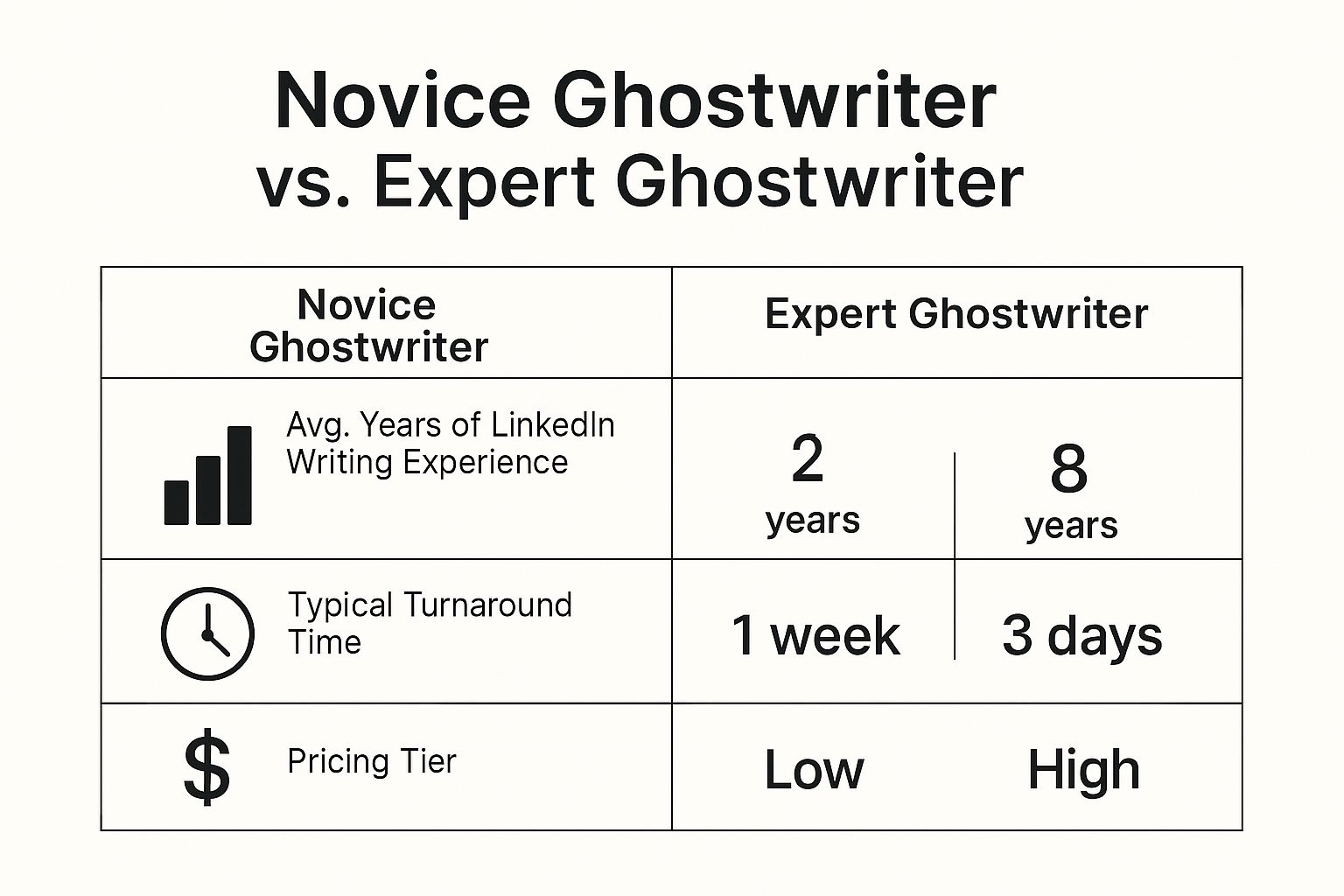A LinkedIn ghostwriter is much more than just someone who writes posts for you. They're a strategic partner, a behind-the-scenes expert who takes an executive's raw ideas, experiences, and vision and translates them into powerful content. It’s a delicate blend of skilled writing and sharp brand strategy, all designed to build authority and hit specific business goals on the platform.
Why Demand For LinkedIn Ghostwriters Is Surging

The job has evolved far beyond just churning out content. These days, a ghostwriter is a core part of a professional’s brand-building machine. Let's face it, busy executives and founders just don't have the bandwidth to consistently create the kind of high-quality, insightful posts needed to stand out.
This is especially noticeable in markets like Germany, where a strong personal brand is directly tied to networking success and new business opportunities. Professionals there are increasingly looking for skilled writers to help them cut through the digital noise and cement their status as industry leaders.
More Than Just A Writer
A top-tier ghostwriter today is part strategist, part content planner, and part analyst. Their real value isn't just in stringing together clever sentences; it’s in their ability to deeply understand a client's unique voice, their industry, and what they’re trying to achieve.
Think of it this way: a ghostwriter's job is to completely embody the client's perspective. It involves deep-dive interviews to capture not just their expertise, but their personality, their stories, and their way of seeing the world. This is what makes the content feel authentic and not like it was written by a committee.
This table breaks down some of the core functions a modern LinkedIn ghostwriter handles.
Key Responsibilities of a Modern LinkedIn Ghostwriter
| Responsibility | Description | Impact on Client's Brand |
|---|---|---|
| Strategic Content Mapping | Developing a comprehensive content plan that directly supports business goals, from lead generation to establishing thought leadership. | Ensures every post has a purpose and contributes to a larger, cohesive brand narrative. |
| Voice & Tone Mastery | Conducting in-depth interviews to capture the client's authentic personality, anecdotes, and unique expertise. | Creates content that sounds genuinely like the client, building trust and relatability with the audience. |
| Performance Analysis | Regularly tracking key metrics (engagement, reach, profile views) to understand what content works and refining the strategy based on data. | Optimises content for maximum impact, ensuring the client's message consistently hits the mark. |
As you can see, this isn't about simply writing posts. It's a holistic approach to building a powerful, opportunity-generating presence on the platform.
The results of this strategic approach are clear. For example, a German case study highlighted a small business owner who, after hiring a LinkedIn ghostwriter, saw a 68% increase in average post engagement. Even more impressively, they experienced a 45% increase in demo requests coming directly from LinkedIn within the first year. You can find more data on this from a study by Column Content.
The ultimate goal is to turn the client's profile into a magnet for opportunities. A great ghostwriter does this by transforming raw knowledge into content that starts real conversations and forges genuine connections.
This evolution means the required skill set has broadened. A successful LinkedIn ghostwriter needs to be incredibly organised, empathetic, and analytical. They have to manage a smooth workflow from the initial idea all the way through to reporting on performance. This foundation is what separates a simple wordsmith from a high-value strategic partner.
Building Your Client Strategy from Day One

Before you even think about writing a single word, the success of your work as a LinkedIn ghostwriter depends entirely on building a rock-solid strategy. The onboarding process is your chance to evolve from a simple writer into a true strategic partner for your client. It’s all about mapping out the entire journey before taking that first step.
Getting this initial phase right is absolutely crucial. It’s what makes the difference between generic content and posts that feel genuinely authentic and drive real business results.
It all kicks off with a deep dive into your client's personal brand. Your job is to understand not just what they do, but who they are, how they think, and what they stand for. This means going way beyond a simple questionnaire. You need to have frank, open conversations to really get to the heart of their core beliefs and professional story. If you're looking for a great starting point, there are some excellent guides on how to build a personal brand from scratch.
Defining the Voice and Vision
Your first major task is to create a detailed tone-of-voice guide. Think of this document as your north star—it’s what will ensure every single post sounds like it came directly from your client. It should capture everything from their specific vocabulary and sense of humour to their unique perspective on their industry.
So, how do you get there? Ask probing questions during your first few interviews:
- How would you explain a complex industry topic to a new employee?
- What's a common myth in your field that you completely disagree with?
- Can you share a story about a mistake you made and what you learned from it?
Questions like these are designed to pull out the authentic stories and personal insights that make content relatable and valuable. The more you can capture their natural way of speaking, the more believable your writing will be.
A great ghostwriter doesn't just mimic a client's voice; they internalise their worldview. The content should feel so authentic that the client themselves feels like they could have written it.
Setting Clear Goals and Content Pillars
Once you've nailed down the brand voice, the next move is to establish clear, measurable goals. What's the main objective here? Is it to generate qualified leads, position them as a keynote speaker, or simply grow their network with industry peers? These goals will shape your entire content strategy.
From these larger goals, you can develop three to five core content pillars. These are the main themes your client will consistently talk about. For a tech CEO, for instance, these pillars might look something like this:
- The future of AI in their industry.
- Leadership lessons learned while scaling a startup.
- Personal productivity habits for busy founders.
This structured approach makes sure every piece of content has a purpose and fits into the bigger picture. It stops you from just posting randomly and helps build a cohesive brand narrative over time.
This kind of strategic thinking is becoming more and more important, especially as LinkedIn's influence continues to grow. In Germany, for example, professionals are increasingly seeking out specialists to help them build trust and engagement on the platform. It's a clear sign of a major business shift toward valuing a professionally curated online presence. You can find more on this trend by checking out these LinkedIn growth experts in Germany on Favikon.
Crafting Content That Captures Attention
https://www.youtube.com/embed/uw1zRLVlClk
Alright, you've got your strategy mapped out. Now for the fun part: turning those ideas into posts that actually stop people from scrolling. This is where your skill as a LinkedIn ghostwriter truly shines. It's not just about sharing information; it's about making people feel something and pay attention.
First things first, remember that most people are scrolling through LinkedIn on their phones. This means formatting isn't just a nice-to-have, it's everything. Big, chunky paragraphs are a complete turn-off on a small screen. Your job is to make the post look inviting and easy to read before they've even processed a single word.
The Anatomy of a Scroll-Stopping Post
There's a reason why the most successful LinkedIn posts all have a similar feel. They're designed to grab you by the collar from the very first line and pull you in.
Think about it: LinkedIn only shows you the first three lines before hiding the rest behind a "see more…" link. That tiny space is your entire sales pitch. You have to land your core idea or an emotional hook right there, or you've lost them.
The hook isn't just about stating the topic. It’s about creating a "curiosity gap" that makes the reader feel like they simply have to click to find out what happens next.
Once you've earned that click, the body of the post has to deliver. This is where you can use short sentences, bullet points, and even single-line paragraphs to build a nice reading rhythm. You want the whole experience to feel effortless.
Balancing Value and Promotion
One of the biggest traps you can fall into is making every post a thinly veiled sales pitch. People can smell that a mile away. The best content feels generous. It’s all about providing genuine value and, in the process, positioning your client as the go-to expert without being pushy.
Here are a few ways to approach this, drawing from your content pillars:
- Tell a real story. A raw, honest post about a past failure and the lesson learned will always outperform a generic list of tips. It builds a human connection and creates trust.
- Offer a contrarian view. Don't be afraid to challenge a popular belief in your client’s industry. It sparks conversation, shows they're a critical thinker, and gets people talking.
- Break down something complex. Take a tricky concept and simplify it into a clear, step-by-step framework. This is an incredible way to demonstrate deep expertise while giving your audience something they can use immediately.
When you consistently provide this kind of value, the promotion takes care of itself. People will naturally start to see your client as a trusted authority, and when they need help, they'll know who to call. If you want to explore more post structures, our guide on creating a great LinkedIn post breaks down several proven formulas.
Your Call to Action Should Start a Conversation
Every post needs to end with a purpose, but on LinkedIn, that purpose isn't always to make a sale. A great call to action (CTA) is about starting a conversation.
Instead of a boring "visit our website," try ending with an open-ended question that ties back to the post. For instance:
"That's the lesson that cost me a year of slow growth. What's a business mistake that ended up teaching you something invaluable?"
This kind of CTA doesn't just ask for a click; it invites people to share their own stories. It turns your post from a monologue into a community dialogue, which is exactly how you build a powerful personal brand. This is how you deliver real results as a ghostwriter.
Building a Workflow That Works for You
As a LinkedIn ghostwriter, your workflow is everything. It's the engine that powers your business. If you want to scale up and manage multiple clients without burning out, you need a system you can rely on. This isn't just about being faster; it’s about freeing up your brainpower to focus on what really matters: crafting brilliant, strategic content.
A solid workflow always starts with a well-organised content calendar. Think of it as the single source of truth for you and your client. It’s where you’ll map out everything—themes, post formats, and of course, the all-important publication dates.
Another trick I've learned is to batch my writing. Instead of tackling one post at a time, I carve out dedicated blocks in my week to write all of a client's content for the next week or two. It’s amazing how much this helps with maintaining a consistent tone and just getting into a productive groove.
Let Technology Do the Heavy Lifting
The right tools can make a world of difference. AI platforms, like Trustypost, are fantastic for acting as a creative partner. You can use them to spin up first drafts based on your client's unique voice and core content pillars. The goal isn't to let the AI run the show, but to use it as a springboard to get past that dreaded blank page.
This is where your expertise truly shines. You take that AI-generated foundation and weave in your client's real-life stories, personal anecdotes, and unique insights. That human touch is what builds genuine connection and trust with their audience. It's completely non-negotiable.
This image really highlights the difference an experienced ghostwriter with a refined process can make.

As you can see, seasoned ghostwriters don't just work faster; they command higher rates. That's a direct result of having an optimised workflow and a strategic mindset.
Essential Tools for the Modern LinkedIn Ghostwriter
To keep everything running smoothly, especially when juggling multiple clients, you need a solid tech stack. These tools aren't just about efficiency; they're about creating a professional, organised experience for your clients.
| Tool Category | Example Tools | Primary Function |
|---|---|---|
| Project Management | Asana, Trello, Notion | Organising content calendars, tracking tasks, and managing client workflows. |
| Content Creation (AI) | Trustypost, Jasper | Generating initial post ideas and drafts based on client voice and pillars. |
| Scheduling | Buffer, Hootsuite | Scheduling approved posts in advance to ensure consistent publishing. |
| Collaboration | Google Docs, Notion | Sharing drafts for client review and gathering feedback in one place. |
| Communication | Slack, Microsoft Teams | Providing a dedicated channel for quick questions and updates. |
By having the right tools in place, you can automate the mundane parts of the job and focus your energy on high-impact creative and strategic work.
Creating a Frictionless Review Process
Nothing grinds a project to a halt faster than a messy review and approval cycle. Forget endless email threads. Instead, use a collaborative tool where your clients can drop comments directly onto the drafts.
A clear, upfront system is your best friend here:
- Establish firm deadlines: Agree on specific times for draft delivery and feedback. This keeps everyone accountable.
- Limit revision rounds: If your initial strategy is on point, one or two rounds of revisions should be plenty.
- Define communication channels: Decide how feedback will be handled. Will it be through document comments, a quick call, or a dedicated Slack channel?
This kind of organised approach prevents delays and keeps everyone on the same page. It’s all about setting clear expectations from the start.
Interestingly, this whole conversation about authenticity is a hot topic in the German business world. Professionals there are particularly cautious about content that feels impersonal or overly automated. German experts often stress that while tools and ghostwriters are valuable, the client must personally edit the final content to maintain credibility. This really reflects a business culture that prizes transparency. You can see more on this authenticity debate on YouTube.
A streamlined workflow isn't just about being faster. It's about building a reliable, professional system that allows you to deliver consistent, high-quality work that clients can depend on.
Driving Engagement and Proving Your Value
Hitting "publish" is just the opening move. For any experienced LinkedIn ghostwriter, that's when the real work kicks off. Your client’s investment isn't paid back in likes—it's earned in the conversations that sprout up in the comments. This is your chance to turn a monologue into a thriving dialogue.
That first hour after a post goes live is golden. You absolutely need a game plan for handling comments and messages right away, because that initial flurry of activity tells the LinkedIn algorithm, "Hey, people are interested in this!" It doesn't mean you have to be chained to your desk, but you do need a solid system in place.
Sparking Real Conversations
The whole point here is to build a genuine community, not just chase vanity metrics. That means your replies need to go way beyond a generic "thanks for your comment." The best engagement always feels personal and actually adds something new to the discussion.
To make this happen without pulling your hair out, sit down with your client and create a response guide. This is a simple document with pre-approved answers and talking points for common questions, compliments, or even pushback. It’s an absolute lifesaver for keeping the tone consistent and your response times quick.
-
Acknowledge and Ask: Always thank the person for their comment, but don't stop there. Ask a follow-up question to keep the ball rolling. If someone agrees with a point you made, you could reply, "Glad it resonated! How have you seen this play out in your own work?"
-
Handle Disagreements with Class: You'll inevitably get some disagreement. Your guide should cover how to respond professionally, turning a potential argument into a healthy debate. Sometimes, a simple, "That's an interesting perspective, I appreciate you sharing it," is all you need to keep things constructive.
-
Tag in Others: If a comment touches on a specific niche or a colleague’s expertise, tag them! Bringing another expert from your client’s network into the conversation is a brilliant way to expand the post's reach and add more value.
This kind of proactive engagement shows your client is tuned in and truly values what their audience has to say—and that’s how you build trust.
A post without engagement is just a broadcast. A post with a thriving comment section is a community hub. Your job is to be the host of the party, making sure everyone feels heard.
Measuring What Truly Matters
To really prove your worth, you need to show more than just a big impression count. It's about connecting your work directly to what your client actually wants to achieve with their business. That means tracking the key performance indicators (KPIs) that show tangible results.
Every client's goals will be a little different, of course, but a few metrics are almost always central to showing a return on investment. The key is not just to report the numbers, but to tell the story behind them.
Here are the metrics I always keep a close eye on:
-
Engagement Rate: This is your bread and butter. A consistently high rate, say 3-5% or more, is clear proof that the content is hitting the mark with the right people.
-
Profile Views: Are more people clicking through to look at your client's profile? That’s a fantastic sign that your content is compelling enough to make them curious.
-
Website Clicks: If lead generation is on the agenda, tracking clicks from their profile or specific posts to the company website is a must. This is a direct line from your content to potential business.
-
Inbound Connection Requests: A steady flow of connection requests from relevant people is a powerful indicator that your content is successfully positioning your client as an authority in their field.
Tying these results back to the strategy you set out at the beginning is what closes the loop. It cements your position not just as a writer, but as a strategic partner. To get a better handle on this, check out our guide on social media KPIs. It’ll walk you through how to track these figures and present a clear picture of the value you're delivering.
Got Questions About LinkedIn Ghostwriting? Let's Talk.

Diving into professional LinkedIn ghostwriting can feel like exploring new territory. It's completely normal to have questions swirling around, especially when it comes to the business side of things—from what to charge to making sure you've got your legal bases covered.
I get it. When I started, I had the same questions. So, let’s clear the air and tackle some of the most common queries I hear. This should give you the clarity and confidence to get started properly.
How on Earth Do I Price My Services?
Figuring out your rates is probably the biggest mental hurdle for any new ghostwriter. There’s no magic number, but there is a logical way to approach it. What you charge really depends on a mix of your experience, the client's industry, and just how much work is involved.
Please, don't just pluck a number from thin air. You need to think about the value you're providing. A great way to frame this is by offering packages instead of charging by the hour. This shifts the conversation from time spent to the results you deliver.
- Monthly Retainers: This is the bread and butter for most ghostwriters. A standard package might offer 12-16 posts a month, along with handling comments and a monthly progress report. If you're new to the game, a good starting point is somewhere in the £800-£1,200 per month range. For seasoned pros who bring deep strategic insight, that figure can easily climb to £3,000 or more.
- Project-Based Fees: Sometimes a client isn't ready for a monthly commitment. For one-off jobs, like a complete profile makeover or a short, sharp content campaign, a flat project fee makes sense.
At the end of the day, your price should reflect the strategic impact you have. You’re not just typing words; you’re a partner in building someone’s professional brand.
Where Do I Actually Find My First Clients?
Landing that first client is a massive win. And honestly, the best place to start is often closer than you think: your own network. Just let your professional connections know what you're doing. You’d be amazed at how many opportunities can pop up from a simple announcement.
Beyond your immediate circle, the key is to show, not just tell. Start by treating your own LinkedIn profile as your very first client. Post consistently. Share genuinely useful insights about content and branding. Get into conversations with people in your target industry.
Your own LinkedIn profile is your most powerful sales tool. Use it to showcase the very skills you’re selling. An active, well-managed profile is living proof that you know how to get results.
Do I Really Need a Contract and All That Legal Stuff?
Yes. A thousand times, yes. You absolutely need a contract. A proper agreement protects both you and your client because it lays out all the expectations, deliverables, and payment details in black and white. It doesn't have to be a 50-page document full of legal jargon, but it must cover the essentials.
Here are the non-negotiables to include in your agreement:
- Scope of Work: Be specific. Detail the number of posts, how revisions work, engagement duties, and reporting.
- Confidentiality (NDA): This gives the client peace of mind that their business information and ideas are safe with you.
- Content Ownership: Make it clear that once they've paid you, they own the content you've created for them.
- Payment Terms: Spell out your rates, when you'll invoice, and what happens if a payment is late.
Putting a solid contract in place from day one sets a professional tone and heads off potential misunderstandings. It shows you’re not just a freelancer; you're a business owner.
Ready to streamline your content creation and manage multiple clients without the headache? Trustypost is your AI-powered partner for crafting on-brand social media content in minutes, not hours. Start your free 7-day trial today and see how effortless social media can be. Find out more at trustypost.ai.



